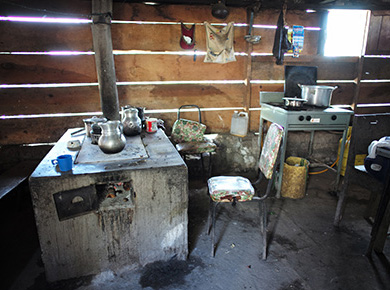Theory-Driven Behavioral Intervention Increases Gas Stove Use
[ad_1]
By Janelle Weaver
Efforts to reduce the enormous health burden related to indoor combustion of solid fuels include replacing those fuels with liquified petroleum gas. A behavioral intervention that promoted gas stove use by pregnant women in rural Guatemala dramatically reduced wood stove use, new research shows. However, the fraction of cooking time represented by gas stove use decreased gradually over subsequent months. The NIEHS-funded study, published on February 14 in BMC Public Health, suggests that other household members need to be involved to promote the sustained, consistent use of gas stoves.
A traditional Guatemalan stove and a liquified petroleum gas stove.
(Photo courtesy of Courtney Lynn Johnson)
“This is an important topic because all too often, technologies are introduced, and after initial enthusiasm, they are abandoned,” said lead author Lisa Thompson, Ph.D., an associate professor in the Nell Hodgson Woodruff School of Nursing, Emory University. “Years of field experience have shown that many cookstove technologies are inconsistently used when behaviors are not well understood, environmental factors are overlooked, and household dynamics are not part of the intervention design strategy.”
Deadly Problem Worldwide
Forty-one percent of people worldwide cook with solid fuels, such as wood, charcoal, coal, crop wastes, and animal dung. Such inefficient cooking and heating practices produce high indoor levels of particulate matter and carbon monoxide, as well as a range of toxic byproducts. Household air pollution is the eighth-leading risk factor for death globally, causing more than four million premature deaths annually due to chronic diseases such as heart disease, stroke, chronic obstructive pulmonary disease, and lung cancer.
Exposure is particularly high in low-income countries and among women and young children. More than half of premature deaths due to pneumonia among children under five are caused by particulate matter inhaled from household air pollution. “Shifting households from using traditional stoves to a new liquefied petroleum gas stove may improve indoor air quality and the health of women and children, but only if the stove meets the demands of the entire household, is practical and affordable, and therefore is used consistently,” said John Balbus, M.D., director of the NIEHS-WHO Collaborating Centre for Environmental Health Sciences.
Theory-Based Behavioral Change
To address this problem, Thompson and her collaborators used a behavioral change intervention based on the capability, opportunity, motivation, and behavior (COM-B) model. This approach involves developing interventions that consider skills and knowledge, social and environmental factors that allow change to occur, and thoughts and emotions that guide behavior. According to the authors, this is the first study to apply behavior change theory to promote the sustained use of clean cookstoves among pregnant women exposed to household air pollution.
The researchers enrolled 50 pregnant women at fewer than 20 weeks gestation. The women received a free liquefied petroleum gas stove, along with ten tank refills, and participated in three classes that covered ways to reduce exposure to household air pollution; proper gas stove use, maintenance, and safety; and how to negotiate with family members the purchase of a fuel tank.
In addition to classes, half of the women participated in a more intensive, tailored intervention that applied the COM-B model and encouraged household-level behavioral change through multiple home visits. For example, other cooks in the home were trained to light and regulate the flame, and spouses were involved in discussions of ways to reduce household air pollution.
Barriers to Sustained Use
The COM-B framework revealed several social challenges that could impede the use of gas stoves. For example, in-laws and parents sometimes prefer wood stoves for heating or cooking, and husbands often decide on large purchases and may not prioritize stove repairs and tank refills. Moreover, some women expressed concerned that their neighbors would think they were too proud for owning a gas stove.
Despite these hurdles, wood stove use decreased dramatically from 6.4 hours per day at the beginning of the study to 1.9 hours per day at 24 to 28 weeks gestation. But from this time until one month post-partum, the fraction of cooking time represented by gas stove use dropped from nearly 60 percent to just over 30 percent. According to the authors, future interventions likely will need to be more complex, last longer, and involve more household members to achieve greater long-term success.
“This study provides valuable insights into how healthy behaviors depend on complex relationships that will vary by region and cultural background,” Balbus said. “Tailoring behavioral change interventions to local contexts could be useful in promoting the use of liquefied petroleum gas stoves and ultimately improving the health of women and children globally.”
Citation: Thompson LM, Diaz-Artiga A, Weinstein JR, Handley MA. 2018. Designing a behavioral intervention using the COM-B model and the theoretical domains framework to promote gas stove use in rural Guatemala: a formative research study. BMC Public Health 18(1):253.
[ad_2]


